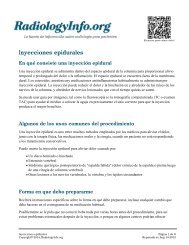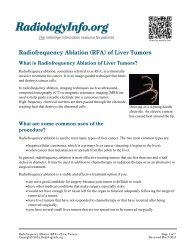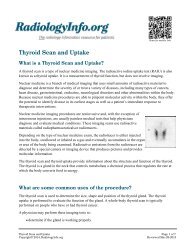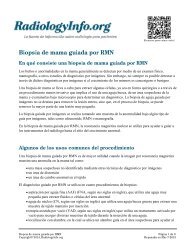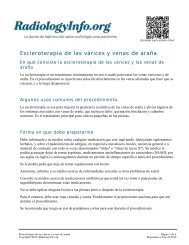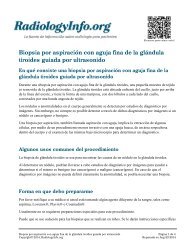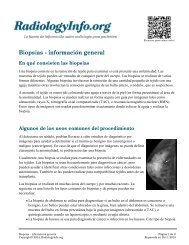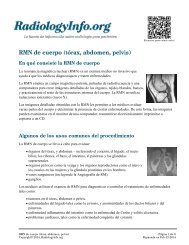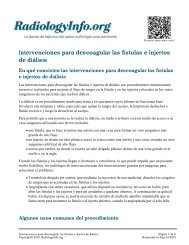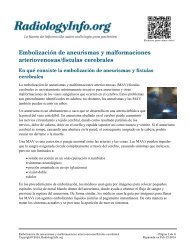Patient Safety: Contrast Materials - RadiologyInfo
Patient Safety: Contrast Materials - RadiologyInfo
Patient Safety: Contrast Materials - RadiologyInfo
You also want an ePaper? Increase the reach of your titles
YUMPU automatically turns print PDFs into web optimized ePapers that Google loves.
Scan for mobile link.<strong>Patient</strong> <strong>Safety</strong>:<strong>Contrast</strong> <strong>Materials</strong>What are contrast materials and how do they work?<strong>Contrast</strong> materials, also called contrast agents or contrast media, are used to improve pictures of theinside of the body produced by x-rays, computed tomography (CT), magnetic resonance (MR) imaging,and ultrasound. Often, contrast materials allow the radiologist to distinguish normal from abnormalconditions.<strong>Contrast</strong> materials are not dyes that permanently discolor internal organs. They are substances thattemporarily change the way x-rays or other imaging tools interact with the body.When introduced into the body prior to an imaging exam, contrast materials make certain structures ortissues in the body appear different on the images than they would if no contrast material had beenadministered. <strong>Contrast</strong> materials help distinguish or “contrast” selected areas of the body fromsurrounding tissue. By improving the visibility of specific organs, blood vessels or tissues, contrastmaterials help physicians diagnose medical conditions.<strong>Contrast</strong> materials enter the body in one of three ways. They can be:swallowed (taken by mouth or orally)administered by enema (given rectally)injected into a blood vessel (vein or artery; also called given intravenously or intra-arterially)Following an imaging exam with contrast material, the material is absorbed by the body or eliminatedthrough urine or bowel movements.There are several types of contrast materials:Iodine-based and barium-sulfate compounds are used in x-ray and computed tomography (CT)imaging exams.<strong>Contrast</strong> materials can have a chemical structure that includes iodine, a naturally occurringchemical element. These contrast materials can be injected into veins or arteries, within thedisks or the fluid spaces of the spine, and into other body cavities.Barium-sulfate is the most common contrast material taken by mouth, or orally. It is also usedrectally and is available in several forms, including:powder, which is mixed with water before administration<strong>Safety</strong>-<strong>Contrast</strong> Page 1 of 7Copyright© 2013, <strong>RadiologyInfo</strong>.orgReviewed Mar-7-2013
liquidpastetabletWhen iodine-based and barium-sulfate contrast materials are present in a specific area of thebody, they block or limit the ability of x-rays to pass through. As a result, blood vessels, organsand other body tissue that temporarily contain iodine-based or barium compounds change theirappearance on x-ray or CT images.Gadolinium is the key component of the contrast material most often used in magnetic resonance(MR) exams. When this substance is present in the body, it alters the magnetic properties ofnearby water molecules, which enhances the quality of MR images.Saline (salt water) and air are also used as contrast materials in imaging exams. Microbubblesand microspheres have been administered for ultrasound imaging exams, particularly exams ofthe heart.Which imaging exams use contrast materials?Oral <strong>Contrast</strong> <strong>Materials</strong>Barium-sulfate contrast materials that are swallowed or administered by mouth (orally) are used toenhance x-ray and CT images of the gastrointestinal (GI) tract, including:pharynxesophagusstomachthe small intestinethe large intestine (colon)In some situations, iodine-based contrast materials are substituted for barium-sulfate contrast materialsfor oral administration.Rectal <strong>Contrast</strong> <strong>Materials</strong>Barium-sulfate contrast materials that are administered by enema (rectally) are used to enhance x-rayand CT images of the lower gastrointestinal (GI) tract (colon and rectum).In some situations, iodine-based contrast materials are substituted for barium-sulfate contrast materialsfor rectal administration.Intravenous <strong>Contrast</strong> <strong>Materials</strong>Iodine-based and Gadolinium-basedIodine-based contrast materials injected into a vein (intravenously) are used to enhance x-ray and CTimages. Gadolinium injected into a vein (intravenously) is used to enhance MR images. Typically theyare used to enhance the:internal organs, including the heart, lungs, liver, adrenal glands, kidneys, pancreas, gallbladder,spleen, uterus, and bladder<strong>Safety</strong>-<strong>Contrast</strong> Page 2 of 7Copyright© 2013, <strong>RadiologyInfo</strong>.orgReviewed Mar-7-2013
gastrointestinal tract, including the stomach, small intestine and large intestinearteries and veins of the body, including vessels in the brain, neck, chest, abdomen, pelvis andlegssoft tissues of the body, including the muscles, fat and skinbrainbreastHow safe are contrast materials?<strong>Contrast</strong> materials are safe drugs; adverse reactions ranging from mild to severe do occur but severereactions are very uncommon. While serious allergic or other reactions to contrast materials are rare,radiology departments are well-equipped to deal with them.How should I prepare for my imaging procedure with contrast material?Because contrast materials carry a slight risk of causing an allergic reaction or adverse reaction, youshould tell your doctor about:allergies to contrast materials, food, drugs, dyes, preservatives, or animalsmedications you are taking, including herbal supplementsrecent illnesses, surgeries, or other medical conditionshistory of asthma and hay feverhistory of heart disease, diabetes, kidney disease, thyroid problems or sickle cell anemiaYou will be given specific instructions on how to prepare for your exam.Side effects and adverse and allergic reactionsBarium Sulfate <strong>Contrast</strong> <strong>Materials</strong>You should tell your doctor if these mild side effects of barium-sulfate contrast materials become severeor do not go away:stomach crampsdiarrheanauseavomitingconstipationTell your doctor immediately about any of these symptoms:hivesitchingred skin<strong>Safety</strong>-<strong>Contrast</strong> Page 3 of 7Copyright© 2013, <strong>RadiologyInfo</strong>.orgReviewed Mar-7-2013
swelling of the throatdifficulty breathing or swallowinghoarsenessagitationconfusionfast heartbeatbluish skin colorYou are at greater risk of an adverse reaction to barium-sulfate contrast materials if:you have a history of asthma, hay fever, or other allergies, which will increase your risk of anallergic reaction to the additives in the barium-sulfate agent.you have cystic fibrosis, which will increase the risk of blockage in the small bowel.you are severely dehydrated, which may cause severe constipation.you have an intestinal blockage or perforation that could made worse by a barium-sulfate agent.Iodine-based <strong>Contrast</strong> <strong>Materials</strong>Mild reactions include:nausea and vomitingheadacheitchingflushingmild skin rash or hivesModerate reactions include:severe skin rash or hiveswheezingabnormal heart rhythmshigh or low blood pressureshortness of breath or difficulty breathingSevere reactions include:difficulty breathingcardiac arrestswelling of the throat or other parts of the bodyconvulsionsprofound low blood pressureA very small percentage of patients may develop a delayed reaction with a rash which can occur hoursto days after an imaging exam with an iodine-based contrast material. Most are mild, but severe rashesmay require medication after discussion with your physician.<strong>Contrast</strong>-Induced Nephropathy<strong>Safety</strong>-<strong>Contrast</strong> Page 4 of 7Copyright© 2013, <strong>RadiologyInfo</strong>.orgReviewed Mar-7-2013
<strong>Patient</strong>s with impaired kidney (renal) function should be given special consideration before receivingiodine-based contrast materials by vein or artery. Such patients are at risk for developingcontrast-induced nephropathy, in which the pre-existing kidney damage is worsened.At-Risk <strong>Patient</strong>sSome conditions increase the risk of an allergic or adverse reaction to iodine-based contrast materials.These include:previous adverse reactions to iodine-based contrast materialshistory of asthmahistory of allergyheart diseasedehydrationsickle cell anemia, polycythemia and myelomarenal diseasethe use of medications such as Beta blockers, NSAIDs, interleukin 2having received a large amount of contrast material within the past 24 hoursBeing at increased risk for an allergic or adverse reaction to contrast material does not necessarily meana patient cannot undergo an imaging exam with contrast materials. Medications are sometimes givenbefore the contrast material is administered to lessen the risk of an allergic reaction in susceptiblepatients.MR-GadoliniumThe contrast material used in MR called gadolinium is less likely to produce an allergic reaction thanthe iodine-based materials used for x-rays and CT scanning. Very rarely, patients are allergic togadolinium-based contrast materials and experience hives and itchy eyes. Reactions usually are mildand easily controlled by medication. Severe reactions are rare.Nephrogenic systemic fibrosis (NSF), a thickening of the skin, organs and other tissues, is a rarecomplication in patients with kidney disease that undergo an MR with contrast material.Gadolinium-based contrast material may be withheld in some patients with severe kidney disease.What will I experience before and after receiving contrast material?Barium-Sulfate Oral and Rectal <strong>Contrast</strong> MaterialIf a barium-sulfate contrast material (given orally or rectally) will be used during your exam, you willbe asked not to eat for several hours before your exam begins. If the contrast material will be givenrectally, you may also be asked to cleanse your colon with a special diet and medication (possiblyincluding an enema) before your exam.If you swallow the contrast material, you may find the taste mildly unpleasant; however, most patientscan easily tolerate it.If your contrast material is given by enema, you can expect to experience a sense of abdominal fullness<strong>Safety</strong>-<strong>Contrast</strong> Page 5 of 7Copyright© 2013, <strong>RadiologyInfo</strong>.orgReviewed Mar-7-2013
and an increasing need to expel the liquid. The mild discomfort will not last long.It is a good idea to increase your fluid intake after an imaging exam involving a barium-based contrastmaterial to help remove the contrast material from your body.Barium-sulfate contrast materials are expelled from the body with feces. You can expect bowelmovements to be white for a few days. Some patients may experience changes in their normal bowelmovement patterns for the first 12 to 24 hours.Iodine-based <strong>Contrast</strong> MaterialWhen an iodine-based contrast material is injected into your bloodstream, you may have a warm,flushed sensation and a metallic taste in your mouth that lasts for a few minutes.The needle may cause you some discomfort when it is inserted. Once it is removed, you mayexperience some bruising.It is a good idea to increase your fluid intake after an imaging exam involving an iodine-based contrastmaterial to help remove the contrast material from your body.Gadolinium-based <strong>Contrast</strong> MaterialWhen the gadolinium is injected, it is normal to feel coolness at the site of injection, usually the arm fora minute or two.The needle may cause you some discomfort when it is inserted. Once it is removed, you mayexperience some bruising.For all of the above administrations of contrast material (barium sulfate, iodine-based,and gadolinium-based):If you have not been sedated, no recovery period is necessary. You may resume your usual activitiesand normal diet immediately after the exam. Increased fluid intake will help eliminate the contrastmaterial from your body.Pregnancy and contrast materialsPrior to any imaging exam, women should always inform their physician or x-ray technologist if there isany possibility that they are pregnant. Many imaging tests and contrast material administrations areavoided during pregnancy to minimize risk to the baby.For CT imaging, if a pregnant woman must undergo imaging with an iodine-based contrast material, thepatient should have a discussion with her referring physician and radiologist to understand the potentialrisks and benefits of the contrast-enhanced scan.For MR imaging, gadolinium contrast material administration is usually avoided due to unknown risk tothe baby, but may be used when critical information must be obtained that is only available with the useof gadolinium-based contrast material.Intravenous <strong>Contrast</strong> Material (Iodine and Gadolinium) and Breast-feeding:Manufacturers of intravenous contrast indicate mothers should not breast-feed their babies for 24 to 48hours after contrast medium is given. However, both the American College of Radiology (ACR) and the<strong>Safety</strong>-<strong>Contrast</strong> Page 6 of 7Copyright© 2013, <strong>RadiologyInfo</strong>.orgReviewed Mar-7-2013
hours after contrast medium is given. However, both the American College of Radiology (ACR) and theEuropean Society of Urogenital Radiology note that the available data suggest that it is safe to continuebreast-feeding after receiving intravenous contrast. The Manual on <strong>Contrast</strong> Media from the ACR states:"Review of the literature shows no evidence to suggest that oral ingestion by an infant of the tinyamount of gadolinium contrast medium excreted into breast milk would cause toxic effects. Webelieve, therefore, that the available data suggest that it is safe for the mother and infant tocontinue breast-feeding after receiving such an agent.If the mother remains concerned about any potential ill effects, she should be given theopportunity to make an informed decision as to whether to continue or temporarily abstain frombreast-feeding after receiving a gadolinium contrast medium. If the mother so desires, she mayabstain from breast-feeding for 24 hours with active expression and discarding of breast milk fromboth breasts during that period. In anticipation of this, she may wish to use a breast pump to obtainmilk before the contrast study to feed the infant during the 24-hour period following theexamination."For further information please consult the ACR Manual on <strong>Contrast</strong> Media and its references. You mayfind it here on the ACR website.DisclaimerThis information is copied from the <strong>RadiologyInfo</strong> Web site (http://www.radiologyinfo.org) which is dedicated to providingthe highest quality information. To ensure that, each section is reviewed by a physician with expertise in the area presented.All information contained in the Web site is further reviewed by an ACR (American College of Radiology) - RSNA(Radiological Society of North America) committee, comprising physicians with expertise in several radiologic areas.However, it is not possible to assure that this Web site contains complete, up-to-date information on any particular subject.Therefore, ACR and RSNA make no representations or warranties about the suitability of this information for use for anyparticular purpose. All information is provided "as is" without express or implied warranty.Please visit the <strong>RadiologyInfo</strong> Web site at http://www.radiologyinfo.org to view or download the latest information.Note: Images may be shown for illustrative purposes. Do not attempt to draw conclusions or make diagnoses by comparingthese images to other medical images, particularly your own. Only qualified physicians should interpret images; theradiologist is the physician expert trained in medical imaging.CopyrightThis material is copyrighted by either the Radiological Society of North America (RSNA), 820 Jorie Boulevard, Oak Brook,IL 60523-2251 or the American College of Radiology (ACR), 1891 Preston White Drive, Reston, VA 20191-4397.Commercial reproduction or multiple distribution by any traditional or electronically based reproduction/publication methodis prohibited.Copyright ® 2013 Radiological Society of North America, Inc.<strong>Safety</strong>-<strong>Contrast</strong> Page 7 of 7Copyright© 2013, <strong>RadiologyInfo</strong>.orgReviewed Mar-7-2013




